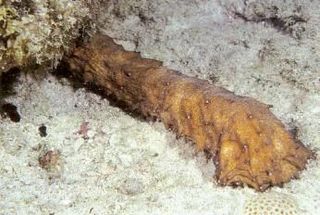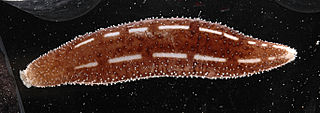
Sea cucumbers are echinoderms from the class Holothuroidea. They are marine animals with a leathery skin and an elongated body containing a single, branched gonad. Sea cucumbers are found on the sea floor worldwide. The number of holothurian species worldwide is about 1,717 with the greatest number being in the Asia Pacific region. Many of these are gathered for human consumption and some species are cultivated in aquaculture systems. The harvested product is variously referred to as trepang, namako, bêche-de-mer or balate. Sea cucumbers serve a useful role in the marine ecosystem as they help recycle nutrients, breaking down detritus and other organic matter after which bacteria can continue the degradation process.

Holothuria is the type genus of the marine animal family Holothuriidae, part of the class Holothuroidea, commonly known as sea cucumbers. Members of the genus are found in coastal waters in tropical and temperate regions. They are soft bodied, limbless invertebrates that dwell on the ocean floor and are usually detritivore. They resemble a cucumber in form. The genus contains some species that are harvested and sold as food.

Sea cucumbers are marine animals of the class Holothuroidea. They are used in fresh or dried form in various cuisines. In some cultural contexts the sea cucumber is thought to have medicinal value.

Holothuria atra, commonly known as the black sea cucumber or lollyfish, is a species of marine invertebrate in the family Holothuriidae. It was placed in the subgenus Halodeima by Pearson in 1914, making its full scientific name Holothuria (Halodeima) atra. It is the type species of the subgenus.

Holothuria thomasi, the tiger's tail, is a species of sea cucumber in the family Holothuriidae. Although it is the largest sea cucumber known in the western Atlantic Ocean, it is so well camouflaged that it was 1980 before it was first described. It is placed in the subgenus Thymiosycia making its full name Holothuria (Thymiosycia) thomasi.

Holothuria arguinensis is a species of sea cucumber in the genus Holothuria, subgenus Roweothuria. It is found in waters off the northeast Atlantic Ocean and Mediterranean Sea. According to some scholarly research, the species is actively expanding its range and colonizing the South-eastern coast of Spain.

Holothuria (Microthele) fuscogilva, also known as the white teatfish or white teeth, is a species of sea cucumber in the genus Holothuria, subgenus Microthele. The cucumber is found in the tropical waters of the Indo-Pacific ocean. The species is vulnerable to over-exploitation from commercial fishing. It was first formally named by Gustave Cherbonnier in 1980.

Holothuria (Microthele) nobilis, the black teatfish, is a species of sea cucumber in the genus Holothuria. The cucumber is found in the tropical waters of the Indo-pacific ocean. It was first described by Selenka in 1867.
Holothuria lessoni, the golden sandfish, is a species of sea cucumber in the genus Holothuria, subgenus Metriatyla. This sea cucumber inhabits the shallow waters of the Indo-Pacific Ocean, where it is found near islands and reef flats. It is highly sought after in commercial and subsistence fishing and the species threatened by overfishing.

Holothuria (Semperothuria) cinerascens is a species of sea cucumber in the genus Holothuria. The sea cucumber is widely distributed in the Pacific and Indian oceans, being found from the Red Sea to Madagascar and from Japan to Australia. It was first described by Brandt in 1835.

Holothuria pervicax is a species of sea cucumber in the genus Holothuria. The sea cucumber has been described as widely spread and has been found in much of the pacific. The cucumber was first described by Selenka in 1867. The cucumber is capable of expelling a relatively large number of cuvierian tubules if disturbed, and is considered toxic if eaten.

Holothuria michaelseni is a species of sea cucumber in the genus Holothuria. The cucumber is found in the eastern Indian Ocean and off the northwest coast of Australia. The species was first described by Erwe in 1913.

Holothuria stellati is a species of sea cucumber in the genus Holothuria. First described by Delle Chiaje in 1823, the species is found in the Mediterranean Sea and grows to a length of 12.9 cm. There are two accepted subspecies of the cucumber, Holothuria stellati dakarensis and Holothuria stellati mammata.

Holothuria (Roweothuria) poli, also known as the White Spot Cucumber, is a species of sea cucumber in the genus Holothuria, subgenus Roweothuria. The species was first described by Delle Chiaje in 1824. The species' range has been documented as being in the Mediterranean Sea, Red Sea, and the Bay of Biscay.
Holothuria (Selenkothuria) bacilla is a species of sea cucumber in the genus Holothuria, subgenus Selenkothuria. First described by Cherbonnier in 1988, the species is found in the Indian Ocean off the coast of Madagascar. One source has also recorded the species as being present in the Persian Gulf. The cucumber is a mobile bottom feeder and lives at a depth of between 5–10 cm.
Holothuria (Cystipus) cubana is a species of sea cucumber in the genus Holothuria, subgenus Cystipus. The cucumber is found in the Western Central Atlantic Ocean and the Caribbean Sea. First described by Ludwig in 1875, Cubana live at a depth of 0-7 meters and grow to a length of 15 cm.
Holothuria (Metriatyla) albiventer is a species of sea cucumber in the genus Holothuria, subspecies Metriatyla. First described by Semper in 1868, the species is distributed in the Western Indian Ocean and the Red Sea. The species is found at a depth of 0-36 meters.

Holothuria (Microthele) whitmaei is a species of sea cucumber in the genus Holothuria, subgenus Microthele. It's common name is the Black Teatfish. The sea cucumber is distributed in the Western Indian and Pacific oceans, with specimens being found off of Tanzania, Pulau, and the Philippines. They are usually found in groups of 5-25 individuals.
Holothuria (Selenkothuria) glaberrima, also known as the Brown Rock Sea Cucumber, is a species of sea cucumber in the genus Holothuria, subgenus Selenkothuria. The cucumber is distributed in the Western Atlantic Ocean, Caribbean Sea, and Gulf of Mexico. The species is found at a depth of 0-42 meters.













